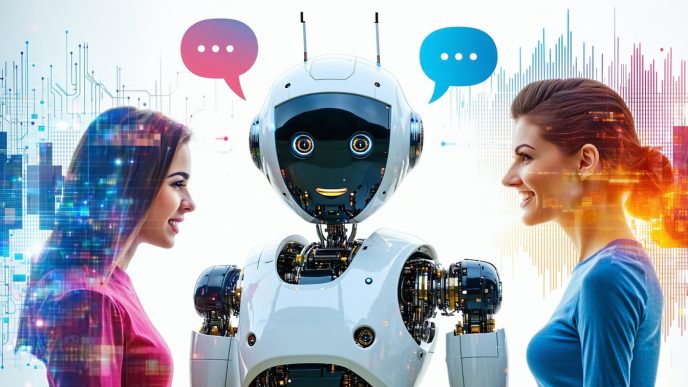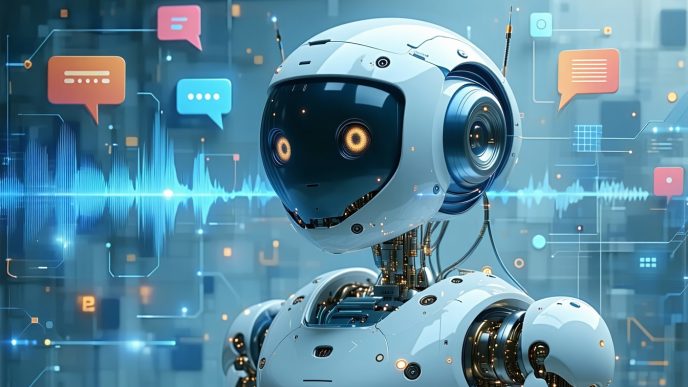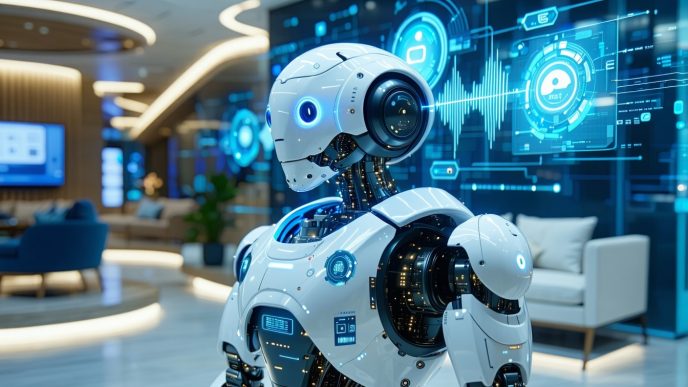Robot Voice Interfaces vs Apps: A Comparison
Understanding Voice Interfaces
Voice interfaces utilize advanced technologies such as voice recognition and natural language processing (NLP) to facilitate interaction between users and robots. These systems enable users to issue commands and engage in conversations with robots through spoken language without the need for any physical input devices. As voice interfaces evolve, they become more adept at understanding context, nuances, and even various accents, making them increasingly effective for real-world applications.
Key characteristics of voice interfaces include:
- Voice Recognition: The ability to accurately detect and interpret spoken commands. This involves converting spoken words into text and understanding their meanings through natural language understanding in robots.
- Conversational Capabilities: The developed ability of robots to maintain a coherent and context-aware conversation with users, often characterized by back-and-forth exchanges.
| Feature | Voice Interfaces |
|---|---|
| Command Input | Spoken commands |
| Interaction Style | Conversational |
| Technology Used | Voice recognition, NLP |
Exploring the Role of Apps in Robot Control
Apps play a crucial role in controlling robots, offering a complementary interface alongside voice capabilities. Apps provide a visual platform that typically allows users to perform tasks, monitor robot activities, and customize settings through an interactive screen.
The advantages of using apps for robot control include:
- Visual Feedback: Users can visualize sensor readings, task progress, and status updates through graphical interfaces, enhancing the overall user experience. This visual component is especially helpful for complex tasks where users need real-time information.
- Customization Options: Many apps allow users to customize robot functions, adjust settings, and develop unique control schemes tailored to their specific needs.
| Feature | Apps |
|---|---|
| Command Input | Touchscreen interactions |
| Interaction Style | Visual, customizable interfaces |
| Technology Used | Graphical user interface (GUI), data visualization |
Both voice interfaces and apps have their unique merits, catering to different user preferences and situations. For a more in-depth understanding of how voice recognition works, refer to our article on robot voice recognition and nlp.
Advantages of Voice Interfaces
Voice interfaces offer distinct advantages when it comes to controlling robots, making them a popular choice among users. Two of the primary benefits include hands-free interaction and natural communication.
Hands-Free Interaction
One of the major benefits of utilizing voice interfaces is the ability for hands-free interaction. This feature is particularly advantageous in situations where users may be multitasking or have their hands occupied. For instance, families can issue commands to household robots while cooking or cleaning, enhancing convenience and efficiency.
By enabling voice commands, users do not need to physically interact with a device or interface, reducing potential interruptions in their workflow or activities. This becomes increasingly important in smart home environments, where users often manage multiple devices.
To highlight the effectiveness of hands-free interaction, consider the following table:
| Use Case | Benefit |
|---|---|
| Cooking | Issue commands without interrupting cooking tasks |
| Cleaning | Control tasks while handling cleaning supplies |
| Busy environments | Engage with devices while multitasking |
Natural Communication
Another significant advantage of voice interfaces is their capacity for natural communication. Users can interact with robots in a way that mimics everyday conversations, leading to a more intuitive experience. This familiarity makes it easier for users, particularly those who are not tech-savvy, to engage and command robots effectively.
Natural Language Processing (NLP) technologies enable robots to understand and respond to user queries in a conversational manner. This technology allows users to ask questions, receive answers, and issue commands without needing to use specific jargon or commands.
Voice interfaces using NLP can also adapt to individual speech patterns, making interactions feel more personal. To learn more about how these systems work, explore our articles on robot voice recognition and nlp and natural language understanding in robots.
The combination of hands-free interaction and the ability to communicate naturally makes voice interfaces a compelling choice for controlling robots, significant for many tech adopters and families interested in smarter home solutions.
Advantages of Apps
Apps provide several advantages when it comes to controlling robots, especially in terms of visual engagement and flexibility. These features enhance user experience and interaction with robotic systems.
Visual Feedback
One significant advantage of using apps for robot control is the availability of visual feedback. Users can see real-time information such as battery status, connectivity, and the robot’s current activity on their screens. This visual representation aids in making informed decisions regarding the robot’s actions.
| Aspect | Benefits |
|---|---|
| Real-time updates | Users can monitor the robot’s performance and status at a glance. |
| Intuitive navigation | Touch interfaces allow for easy manipulation of commands and settings. |
| Enhanced control | Visual elements make it easier to configure complex tasks or settings. |
For further insights into how robotic systems utilize voice recognition, view our article on robot voice recognition and nlp.
Customization Options
Apps also offer significant customization options, allowing users to tailor the controls and settings according to their preferences. This flexibility can lead to a more personalized experience while interacting with robots.
| Customization Feature | Description |
|---|---|
| Task configuration | Users can set specific tasks and sequences for the robot to execute. |
| User preferences | Options to adjust settings based on individual preferences enhance usability. |
| Integration | App customization can include syncing with other smart home devices, facilitating a unified experience. |
For more on how robots understand and respond to commands, check out our article on natural language understanding in robots.
By exploring the advantages of apps, tech adopters and robotics enthusiasts can see how they complement voice interfaces. The combination of visual feedback and customization features contributes to a robust user experience in robotic interaction.
Limitations of Voice Interfaces
While voice interfaces provide an innovative way to control robots, they are not without their limitations. Understanding these challenges is essential for both users and developers as technology advances.
Potential Misinterpretation
Voice interactions can lead to potential misinterpretation of commands. Even with advanced technology, robots may struggle to fully understand certain phrases or accents. Factors such as background noise, speech clarity, and even regional dialects can impact the accuracy of voice recognition systems.
The table below highlights common issues related to voice misinterpretation and their potential causes:
| Issue | Description | Potential Causes |
|---|---|---|
| Command Confusion | The robot misunderstands a command or executes the wrong action. | Similar-sounding words, noise interference, unclear pronunciation. |
| Accents and Dialects | Difficulty in accurately interpreting varying speech patterns. | Diverse accents, regional dialects, limited training data. |
| Context Misunderstanding | Lack of understanding of context can lead to incorrect responses. | Ambiguous language, lack of situational awareness. |
For more on how robots process voice commands, check out our article on robot voice recognition and nlp.
Privacy Concerns
Privacy is another significant concern associated with voice interfaces. Users may be wary of how their voice data is collected, stored, and utilized. With continuous voice recognition systems, there is a risk that personal conversations could be recorded or misused.
The main privacy issues surrounding voice interfaces are summarized in the table below:
| Concern | Description | Example |
|---|---|---|
| Data Storage | Users may not know how long their voice data is retained. | Recorded commands may be stored indefinitely. |
| Unauthorized Access | Potential for third parties to access and misuse voice data. | Hacking incidents could expose sensitive information. |
| Lack of Transparency | Users may not fully understand privacy policies. | Complex terms of service make it difficult to know how data is used. |
Those interested in the implications of data privacy in robotic systems may refer to our article on voice command accuracy in robots to explore this further.
Limitations of Apps
While applications provide valuable tools for robot control, there are notable limitations that users should consider, particularly regarding their reliance on screen interaction and the challenges presented by the learning curve.
Dependency on Screen Interaction
Applications for robot control typically require users to interact through screens, which can limit the overall experience. This dependency on a visual interface may hinder accessibility for those who prefer more direct interactions or have difficulty using touchscreens. Users must focus on their devices rather than the robot itself, which can detract from the intuitive experience that voice interfaces aim to offer.
The table below illustrates common screen interaction issues associated with robot control apps:
| Issue | Description |
|---|---|
| Distraction | Users may become distracted by their mobile screens rather than engaging with the robot. |
| Accessibility | Individuals with visual impairments may find it challenging to navigate apps effectively. |
| Complexity | A variety of app features may overwhelm users, leading to frustration. |
Learning Curve
Another limitation of apps is the learning curve associated with their use. Many users may find it difficult to understand how to operate the app initially, especially if it has a complex interface or requires detailed setup. This learning process can be time-consuming and can inhibit users from fully utilizing the robot’s capabilities.
The complexity can also vary based on the app’s design and the advanced features it offers. Here is a breakdown of the factors influencing the learning curve:
| Factor | Description |
|---|---|
| User Experience | A cluttered or unintuitive design can increase the time it takes for users to familiarize themselves with the app. |
| Features | Advanced options may require additional knowledge, making the initial use more challenging. |
| Updates | Frequent updates might introduce new features that necessitate relearning parts of the app. |
By acknowledging these limitations, users can make more informed choices when comparing robot voice interfaces vs apps and select the interaction method that best suits their needs. Understanding these challenges helps robotics enthusiasts and smart home users navigate the evolving landscape of robot interaction effectively. For additional insights into how robots process commands, see our articles on natural language understanding in robots and robot voice recognition and nlp.
Evolving Technologies
As technology advances, the integration of voice interfaces and applications for robot control is becoming increasingly seamless. This evolution reflects a growing trend towards enhancing user experience and expanding the capabilities of robots.
Integration of Voice and App Controls
The combination of voice interfaces and applications allows users to interact with robots in more versatile ways. Voice commands can be complemented by visual feedback from an app, creating a more comprehensive control system. This integration enhances user engagement and satisfaction, enabling users to make quick adjustments through voice or visual input.
Table 1 below highlights key elements in the integration of voice and app controls:
| Feature | Voice Interface | App Control |
|---|---|---|
| Interaction Type | Hands-free commands | Screen-based interaction |
| Feedback | Audio responses | Visual responses |
| Customization | Limited | Extensive |
| Accessibility | High | Moderate |
The ability to use both voice commands and app controls means users can adapt their interactions based on preferences or the specific task at hand. The integration also supports enhanced functions such as natural language understanding and more accurate command recognition. For more insight into the technologies behind these capabilities, refer to our article on natural language understanding in robots.
Future Trends in Robot Interaction
Looking ahead, trends in robot interaction are centered around improving the effectiveness and efficiency of both voice interfaces and app controls. Emerging technologies, such as artificial intelligence and machine learning, are playing a pivotal role in these developments.
Some anticipated trends include:
-
Enhanced Voice Recognition: Future robots will likely feature advanced voice recognition systems, refining command accuracy and minimizing misunderstandings. This is critical for creating a more natural conversation flow. For further details, explore our article on voice command accuracy in robots.
-
Personalization: Robots will increasingly be able to adapt their responses based on user preferences, creating a tailored interaction. Features like robot responses and personality design will become significant in developing relatable and engaging experiences.
-
Multilingual Capabilities: As robots continue to enter diverse environments, there will be an emphasis on training them to understand various accents and languages. For more information, see our article on training robots to understand accents.
-
Improved Conversation Skills: The ability of robots to hold conversations will be enhanced, utilizing insights from conversation capabilities in robots research. This progression aims to make interactions feel more organic.
As these trends unfold, the landscape of robot interaction will evolve, offering a more integrated and user-friendly approach that caters to the needs of tech adopters and smart home users alike. For a closer look at the future of voice interaction with robots, check out our article on future of voice interaction with robots.















